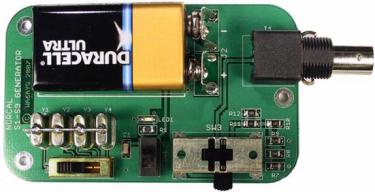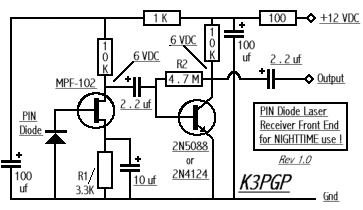Today I tried two experiments. Firstly a continuation of my tests with the loop and E-field probe out in the fens on 8.977kHz and then tonight, another over-the-horizon test on 481THz.
Failure 1 at VLF: whereas in the past I've had a decent signal at my test site at Tubney Fen 3.5km from home on the loop antenna on 8.977kHz, today I could copy
nothing. There was some strong interference and I thought that may have been the problem, so I moved on to a second test site 5km away where again I usually get a good signal. Again nothing. In the past this second site has given me signals so strong that I could copy 10wpm CW from home on 1kHz by earth mode. Now around the village and in nearby Swaffham Prior the signal levels were (as far as I can recall) similar to past levels, so what has changed? One theory is that the wet winter has saturated the fenland soil so conductivity is much higher, resulting in much higher attenuation at VLF. Another possibility is some utility has changed - a change of pipe type or a re-routing of an electricity cable? My TX and RX equipment is largely the same as in previous tests.
 |
| Optical QRM on the 820Hz sub-carrier frequency |
Failure 2 at 481THz: I tried a third attempt at my over-the-horizon QRSS3 reception of my signal on a 820Hz sub-carrier. This has been successful in the past. The 100mm lens TX was carefully aligned just to the right of our local windmill on "the hill" and I traveled to what should have been a direct line path (but over the horizon so the signal has to be scattered) about 3.5km away. Optical conditions looked good with clear visibility of street lights in Burwell. Well, I am pretty certain that I was able to
hear my signal by ear in the headphones keying away slowly, but because of a lead failure (later fixed) and then a strong interfering signal very close to the 820Hz sub-carrier, I failed to see my signal with Spectran and make a screen capture. I think this QRM signal is related to new street lighting as panning the horizon brought up this interference on most street lights at around 3km range. The solution will be to choose a different sub-carrier tone frequency. BTW, it is fun to hear the strobe lights from aircraft: these are very strong and can be copied well off the direct path by scattering.
My next immediate priority is to change the optical beacon TX so that I can use a range of different sub-carrier frequencies all derived from an HF crystal divided down with a 4060 divider. This will also allow me to run a continuous signal which will help with alignment and I can avoid QRM by moving the HF crystal frequency if needed. I could also arrange DFCW modulation by FSK keying the HF crystal: this will allow a continuous signal for audible alignment yet be detectable with software packages like Spectran in QRSS3.
As regards the VLF earth-mode tests, for now I am going to draw these to a halt and will try again in a month or so when I hope the fen soil conductivity has reduced. If things are unchanged then I suspect that something in the utilities metalwork out in the fens has (permanently) changed.




 Having done a bit of eBay trading this last few weeks, I'm surprised how expensive it now is to send a small packet by post using Royal Mail or Parcel Force, even more so if sending it abroad. Unless I have misunderstood the incredibly confusing information on how to send a small packet to Germany, one weighing 760g costs an astounding £6.62. Go above 1kg and the rates are extortionate.
Having done a bit of eBay trading this last few weeks, I'm surprised how expensive it now is to send a small packet by post using Royal Mail or Parcel Force, even more so if sending it abroad. Unless I have misunderstood the incredibly confusing information on how to send a small packet to Germany, one weighing 760g costs an astounding £6.62. Go above 1kg and the rates are extortionate. 




 There are a few other books and some baby clothes too if you, or your XYL, are interested. My aim is to declutter the shack as much as I can before the house move. The other books include some on disability related subjects, psychology
and the Galapagos Islands (the latter is a very nice BBC book).
There are a few other books and some baby clothes too if you, or your XYL, are interested. My aim is to declutter the shack as much as I can before the house move. The other books include some on disability related subjects, psychology
and the Galapagos Islands (the latter is a very nice BBC book).





 The radio books are QRP Basics by George Dobbs. This is an essential guide to low powered radio operating. As I have the newer edition, this first edition version is for sale. Highly recommended book.
The radio books are QRP Basics by George Dobbs. This is an essential guide to low powered radio operating. As I have the newer edition, this first edition version is for sale. Highly recommended book. The next is LF Today by Mike Dennison G3XDV which is the first version of the guide to LF operating especially on 136kHz, although invaluable for 472kHz too. I used this version extensively when first setting up to TX on 136kHz.
The next is LF Today by Mike Dennison G3XDV which is the first version of the guide to LF operating especially on 136kHz, although invaluable for 472kHz too. I used this version extensively when first setting up to TX on 136kHz.




 For the second month in a row I have an article in Practical Wireless. This time it is one submitted several years ago describing my operation on 70cms FM when on holiday in New Zealand in 2009. New Zealand has an excellent internet-linked repeater network that links repeaters all across the country, so one can work from the very south of South Island all the way to the top of North Island and talk to anyone on this linked network. I found this invaluable when on holiday.
For the second month in a row I have an article in Practical Wireless. This time it is one submitted several years ago describing my operation on 70cms FM when on holiday in New Zealand in 2009. New Zealand has an excellent internet-linked repeater network that links repeaters all across the country, so one can work from the very south of South Island all the way to the top of North Island and talk to anyone on this linked network. I found this invaluable when on holiday.









